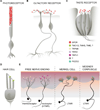Mechanically Activated Ion Channels
- PMID: 26402601
- PMCID: PMC4582600
- DOI: 10.1016/j.neuron.2015.08.032
Mechanically Activated Ion Channels
Erratum in
- Neuron. 2015 Oct 21;88(2):433
Abstract
Mechanotransduction, the conversion of physical forces into biochemical signals, is essential for various physiological processes such as the conscious sensations of touch and hearing, and the unconscious sensation of blood flow. Mechanically activated (MA) ion channels have been proposed as sensors of physical force, but the identity of these channels and an understanding of how mechanical force is transduced has remained elusive. A number of recent studies on previously known ion channels along with the identification of novel MA ion channels have greatly transformed our understanding of touch and hearing in both vertebrates and invertebrates. Here, we present an updated review of eukaryotic ion channel families that have been implicated in mechanotransduction processes and evaluate the qualifications of the candidate genes according to specified criteria. We then discuss the proposed gating models for MA ion channels and highlight recent structural studies of mechanosensitive potassium channels.
Copyright © 2015 Elsevier Inc. All rights reserved.
Figures



References
-
- Albuisson J, Murthy SE, Bandell M, Coste B, Louis-Dit-Picard H, Mathur J, Feneant-Thibault M, Tertian G, de Jaureguiberry JP, Syfuss PY, et al. Dehydrated hereditary stomatocytosis linked to gain-of-function mutations in mechanically activated PIEZO1 ion channels. Nature communications. 2013;4:1884. - PMC - PubMed
Publication types
MeSH terms
Substances
Grants and funding
LinkOut - more resources
Full Text Sources
Other Literature Sources

